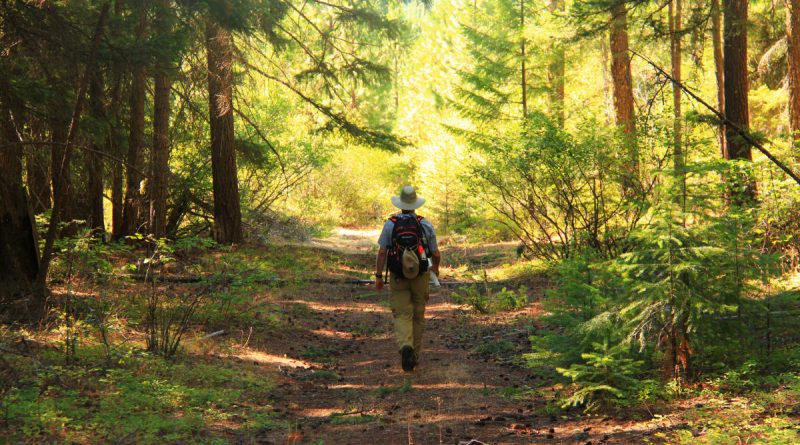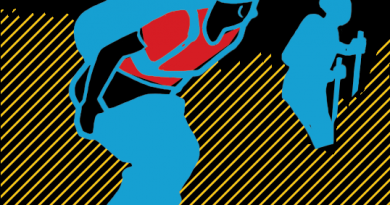The Hike Forever Fitness Plan: Age 50-65
Fight the sedentary lifestyle and get a move on with these exercises and essential skills.
Your Body
Aging alone does not a weaker person make. A sedentary lifestyle is what really puts the skids on health and well-being. Starting at about age 50, the fight for fitness has one front that you can’t control (age-related muscle losses, called sarcopenia) and one that you can (exercise). How you’ll win: regular workouts. “At 65, you can maintain muscle mass at 90 percent of what you had when you were 20 or 30,” says Greg Heath, professor of health and human performance at the University of Tennessee-Chattanooga. Even quasi-sedentary Johnnies-come-lately can regain 70 percent of the fitness they had as 20- to 35-year-olds by getting back into a steady exercise program.

A: Heart Lower stroke volume–a result of stiffening tissues–means that each heartbeat circulates less oxygenated blood to O2-loving muscles. Stiffening capillaries also constrict blood flow, causing blood pressure to creep up. That’s bad news, especially at altitude. The Fix: Hike, hike, hike. It stimulates your Frank-Starling mechanism (the body’s way of compensating for the lower heart rate that comes with aging), which in turn increases heart-stroke volume. And eat foods containing vitamin K (parsley, watercress)
B: Lungs That sucking sound at altitude? It’s due in part to weakened diaphragm and rib muscles making breaths shallower and less efficient. The fix: Endurance hiking–twice a week for 45 minutes at a perceived exertion of at least 13 –will keep your lungs and chest wall elastic.
C: Feet Sustained pounding makes your feet grow longer and wider, an effect compounded by age. The fix: Buy the right-size boots for your feet, and get a new pair before your old ones are trashed, or visit a podiatrist, who can fix your foot ailments with a variety of orthotics.
D: VO2Max The maximum oxygen your muscles can use per minute has decreased about 10 percent since your twenties–up to 30 percent if you’re sedentary. The fix: Short, intense workout bursts (10-15 minutes, 3 times a week) will crank it back up. Older adults can achieve 10 to 30 percent gains in less than three months, according to a report by the University of Washington Department of Family Medicine.
E: Bones As you near 50, your body naturally begins losing more bone than it’s creating. This ups the risk for osteoporosis, which makes bones fragile. The fix: Load up on dairy (milk, which is fortified with vitamin D, is better than yogurt or cheese) and leafy greens to get your requisite 1,200 milligrams of daily calcium and 400 IU of vitamin D.
F: Joints/cartilage/back Cartilage loss isn’t conclusively linked to age, but wear-and-tear does thin the cushioning between joints, particularly in the knees, spine, and hips. The fix: Compensate by strengthening the muscles in these areas that support balance, and the nerves that control stability. Stand on one leg–like a flamingo–and do partial squats, or swing your trunk from side to side. Bonus: This is great prep for a Grand Canyon hike, or any trail with high, awkward steps.
G: Muscles Studies have shown a loss of roughly 10 percent of total muscle fiber per decade in sedentary adults after 50. The fix: Don’t sit still. Your body only feeds what it needs–unused muscle is denied energy and oxygen supply. Make muscles necessary by strength-training major groups 3 times a week, and cross-train to spread the fitness benefit.
Eat Right and Stay in Shape
The best way to burn unwanted body fat (one of the “gifts” of middle age) is through good nutrition. It sounds contradictory, but according to dietician Esther Cohen, eating more omega-3 fatty acids will help trim your waistline. Found in “wild meat,” like grass-fed beef, organ meat, and especially wild salmon, trout, and sardines, omega-3s help the body metabolize stored fat into energy. They also strengthen immunity, decreasing the risk of chronic illness
Muscle Mix
Fuel up–and aid recovery–with this long- trail longevity formula full of omega-3 fatty acids and antioxidants.
1 cup raw pine nuts
1 cup pumpkin seeds
2 cups spicy southwest walnuts with cayenne and cumin
1/2 cup sesame seeds
1 cup black currants
3/4 cup dates, chopped
1 cup dried apples, chopped
Ancient Superfood
3,000 years ago, aztec indians munched chia seeds before running long distances. chia seeds have high doses of omega-3 fatty acids, lots of fiber, and protein to speed recovery after long runs.
Cross-train for big fitness gains
1. Mountain biking Pedaling up steep, uneven terrain builds leg power while giving joints a break. It also activates core muscles, important for combating the compressive forces of backpacking on the spine. Sub 8-10 hilly miles into your normal routine once or twice a week.
2. Road biking Great for endurance and explosive power, cycling enables prolonged training at sustained, varied intensities with none of the impact associated with running. Intervals increase VO2max. Ride 15-25 miles on hilly roads (varying your pace between mild and maximum exertion) once or twice a week.
3. Swimming Yes! A zero-impact sport that builds mega-endurance and lungs like Michael Phelps (okay, maybe). A freestyle stroke promotes full range of motion in shoulders and back, which battles stiffness, and resistance builds cardiovascular and muscular strength. Do .25 to .5 mile on endurance days.
Longevity Pose
Child’s Pose to Down Dog
This yogic cure-all strengthens shoulders to help erase pack pain, a common complaint among baby boomers. It also releases hamstrings and calves. How: Child’s Pose: Sit on your heels with the tops of your feet touching the ground. fold over your bent legs, reaching your arms in front of you. press palms into the ground and hang your head between them. Hold 5-10 breaths. Down dog: tuck your toes under, press into your hands, and lift your hips up and back. straighten your legs as much as possible and let your heels hang heavy. Hold 5-10 breaths.

Pad Your Peds
As you age you lose fat in the one place you want it: your feet. Make up for lost cushion–and increase comfort–by choosing your hiking socks carefully.
Trail mix recipes by Esther Cohen (sevenbowls.com)
Yoga poses by Margaret Burns Vap (bigskyyogaretreats.com)
Common Ailment: Compressed Vertebrae
Years of use (and abuse) can wear away the padding between bones. For backpackers, this can be especially severe in the back–a painful arthritic condition called spinal stenosis. Compressed vertebrae choke off blood flow to nerve roots, resulting in an aching or numbing sensation. “Legs cramp and the more you walk, the more it hurts,” says Kelly, the orthopedist.
Prevent Use hiking poles to shift your body weight forward. “A forward-leaning posture will open up space for the nerve roots,” Kelly says, and alleviate pain.
Soothe Pop an anti-inflammatory and sit with your back curved forward. If you can’t get relief, ditch your pack and walk slowly back to the trailhead, using hiking poles to support a comfy position.
Strengthen Abdominal muscles support the spine. Work on your six-pack with crunches. Kelly prescribes 3 sets of 8 to 12 reps every day. As you get stronger, increase resistance by doing crunches while holding a small weight (5 pounds) behind your head.
The article was originally seen at https://www.backpacker.com/skills/fitness-special-mdash-hike-forever-age-50-65
Originally posted 2018-04-10 16:34:55.




